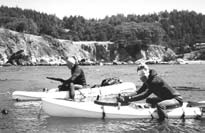Go Where No Diver Has Gone BeforeContents of this Issue: Komodo Dancer, Flores Sea, Indonesia Did Gabe Watson Get Away With Murder? Dive Instructor Jailed for Being Alone With Her Boss Divers, You’re Not Using Enough Sunscreen Can Saunas Prevent Decompression Sickness? Go Where No Diver Has Gone Before Where Have Hawaii’s Fish Gone? Passport Tips for Traveling Divers Dive Gear Warranties: Always Honored? Editorial Office: Ben Davison Publisher and Editor Undercurrent 3020 Bridgeway, Suite 102 Sausalito, CA 94965 try diving from a kayak from the July, 2009 issue of Undercurrent
If you’re a diver who complains about crowded sites and longs for tranquility, read on. On a kayak, you’re the captain, and you can steer it wherever you please. Many divers use kayaks to extend their range, and there are so many reasons why they’re worth the effort. After launching a kayak from a beach or ramp, a diver can paddle to secluded sites or where shore access is restricted. Entry and exit through surf are generally easier. You can stay warmer and dryer before and after the dive. You’re more rested upon reaching the dive site. Kayaks can get through or into tight places. A kayak provides you a way to get out of the water and a platform to rest on between dives and converse with your buddy. You can tote your lunch. You can even take an extra tank or two. They have anchor lines to help your ascent and descent. They can carry sonar, GPS and radios or phones. They’re low maintenance; once you own one, it costs nothing to operate. However, kayaking skills are crucial. You must know how to right yourself if you capsize, as well as how to manage currents and rip tides. For free diving or scuba diving, a sit-on-top kayak is preferred. Look for sealable hatches, which keep personal items dry (you’ll still need a dry sack) and contain them safely should you capsize. A stretchy leash will secure your paddle while you’re diving. An open stern will hold tanks and BCDs (secured by straps or bungees). Some PADI and NAUI instructors offer kayak diving certifications. However, neither agency could supply Undercurrent with their locations or contact information, so you need to contact a local PADI or NAUI facility (search online at www.padi.com or www.nauitec.com) to see if instruction is available. Most kayak diving instructors are based on the West Coast. One shop that offers PADI kayak diving certification is Aqua Safaris of Santa Cruz, CA (831-479-4386, www.aquasafaris.com). KayakDiving.com offers an instructional CD-ROM for $15. At TopKayaker.net (www.sit-on-topkayaking.com), you’ll find articles for divers compiled from several sources (click on “Diving”). It also offers basic how-to guidelines and e-tails kayak diving accessories.
Some dive shops such as Sub-Surface Progression in California’s Mendocino County (www.subsurfaceprogression.com) rent dive kayaks (they don’t require a certification, by the way). Others, such as OEX Dive & Kayak Center in La Jolla near San Diego (www.oeexpress.com) offer guided tours. But many dive shops and resorts specifically forbid diving from rental kayaks. A few resorts, such as Blackbird Caye in Belize, allow guests to snorkel off kayaks but generally their boats are too small for scuba. Captain Don’s Habitat in Bonaire offers kayak scuba diving and certification. But few other tropical dive operators have picked up on the concept. That’s a shame, especially because many people believe that the lack of adventure in diving has caused the Gen Y twentysomethings to seek other sports. Kayak diving can provide that kind of adventure. P.S.: Kayaks run from $600 to more than $1,400. Ocean Kayak makes several popular models; other brands include Necky, Hobie, Cobra and Native Watercraft. Do comparison shopping at outdoor gear retailers Clavey (www.clavey.com) and Dive and Kayak (www.diveandkayak.com). You’ll also need a roof rack for your vehicle, or get a buddy with a rack that holds two kayaks.) Beach wheels that fold up and can be stored inside a hatch are helpful for schlepping the kayak from the parking lot. Finally, a very important tip: Get the best seat you can afford, because good back support makes a huge difference when paddling. - - Larry Clinton |

I want to get all the stories! Tell me how I can become an Undercurrent Online Member and get online access to all the articles of Undercurrent as well as thousands of first hand reports on dive operations world-wide
| Home | Online Members Area | My Account |
Login
|
Join
|
| Travel Index |
Dive Resort & Liveaboard Reviews
|
Featured Reports
|
Recent
Issues
|
Back Issues
|
|
Dive Gear
Index
|
Health/Safety Index
|
Environment & Misc.
Index
|
Seasonal Planner
|
Blogs
|
Free Articles
|
Book Picks
|
News
|
|
Special Offers
|
RSS
|
FAQ
|
About Us
|
Contact Us
|
Links
|
3020 Bridgeway, Ste 102, Sausalito, Ca 94965
All rights reserved.


